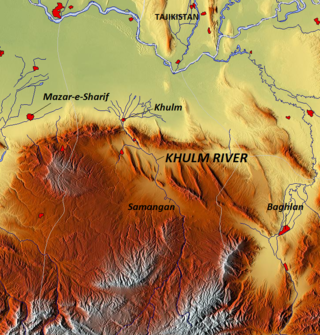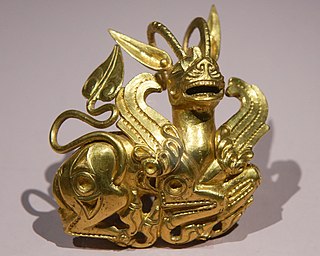
The Amu Darya, also called the Amu, the Amo, and historically the Oxus, is a major river in Central Asia and Afghanistan. Rising in the Pamir Mountains, north of the Hindu Kush, the Amu Darya is formed by the confluence of the Vakhsh and Panj rivers, in the Tigrovaya Balka Nature Reserve on the border between Afghanistan and Tajikistan, and flows from there north-westwards into the southern remnants of the Aral Sea. In its upper course, the river forms part of Afghanistan's northern border with Tajikistan, Uzbekistan, and Turkmenistan. In ancient history, the river was regarded as the boundary of Greater Iran with Turan, which roughly corresponded to present-day Central Asia. The Amu Darya has a flow of about 70 cubic kilometres per year on average.

Bactria, or Bactriana, was an ancient Iranian civilization in Central Asia based in the area south of the Oxus River and north of the mountains of the Hindu Kush, an area within the north of modern Afghanistan. Bactria was strategically located south of Sogdia and the western part of the Pamir Mountains. The extensive mountain ranges acted as protective "walls" on three sides, with the Pamir on the north and the Hindu Kush on south forming a junction with the Karakoram ranges towards the east.

Khwarazm or Chorasmia is a large oasis region on the Amu Darya river delta in western Central Asia, bordered on the north by the (former) Aral Sea, on the east by the Kyzylkum Desert, on the south by the Karakum Desert, and on the west by the Ustyurt Plateau. It was the center of the Iranian Khwarezmian civilization, and a series of kingdoms such as the Afrighid dynasty and the Anushtegin dynasty, whose capitals were Kath, Gurganj and—from the 16th century on—Khiva. Today Khwarazm belongs partly to Uzbekistan and partly to Turkmenistan.

The Bactria–Margiana Archaeological Complex (BMAC) is the modern archaeological designation for a particular Middle Bronze Age civilization of southern Central Asia also known as the Oxus Civilization. The civilization's urban phase or Integration Era, was dated in 2010 by Sandro Salvatori to c. 2400–1950 BC, but a different view is held by Nadezhda A. Duvoba and Bertille Lyonnet, c. 2250–1700 BC.

The Massagetae or Massageteans, also known as Sakā tigraxaudā or Orthocorybantians were an ancient Eastern Iranian Saka people who inhabited the steppes of Central Asia and were part of the wider Scythian cultures. The Massagetae rose to power in the 8th to 7th centuries BCE, when they started a series of events with wide-reaching consequences by expelling the Scythians out of Central Asia and into the Caucasian and Pontic Steppes. The Massagetae are most famous for their queen Tomyris's alleged defeating and killing of Cyrus, the founder of the Persian Achaemenid Empire.

The Zarafshon is a river in Tajikistan and Uzbekistan in Central Asia. Its name, "spreader of gold" in Persian, refers to the presence of gold-bearing sands in the upper reaches of the river. To the ancient Greeks it was known as the Polytimetus. It was also formerly known as Sughd River. The river is 877 kilometres (545 mi) long and has a basin area of 17,700 square kilometres (6,800 sq mi).

Termez is the capital of Surxondaryo Region in southern Uzbekistan. Administratively, it is a district-level city. Its population is 182,800 (2021). It is notable as the site of Alexander the Great's city Alexandria on the Oxus, as a center of early Buddhism, as a site of Muslim pilgrimage, and as a base of Soviet Union military operations in Afghanistan, accessible via the nearby Hairatan border crossing.
As an abbreviation, AMU may refer to:

Komedes is the ethnonym of an ancient people in Central Asia. They were mentioned by the ancient Greek geographer Ptolemy in Geography. Traditional Hindu and Indian spellings included Kumuda, Kumuda-dvipa, and Parama Kambojas; and ancient Greek and Roman spellings included Komedes, Komedei, Traumeda, Caumedae, Homodotes, Homodoti, or Homodontes.

Shortugai (Shortughai), in Darqad District of northern Afghanistan, was a trading colony of the Indus Valley civilization established around 2000 BC on the Oxus river near the lapis lazuli mines. It is considered to be the northernmost settlement of the Indus Valley Civilization. According to Bernard Sergent, "not one of the standard characteristics of the Harappan cultural complex is missing from it".
The name Khwarazmian may refer to:

The Uzboy was a distributary of the Amu Darya which flowed through the northwestern part of the Karakum Desert of Turkmenistan until the 17th century, when it abruptly dried up, eliminating the agricultural population that had thrived along its banks..

Takht-i Sangin is an archaeological site located near the confluence of the Vakhsh and Panj rivers, the source of the Amu Darya, in southern Tajikistan. During the Hellenistic period it was a city in the Greco-Bactrian kingdom with a large temple dedicated to the Oxus, which remained in use in the following Kushan period, until the third century AD. The site may have been the source of the Oxus Treasure.

The Khulm River is a river of north-central Afghanistan. In its lower course, it passes through Khulm and Haybak in Balkh Province. The Khulm is a tributary to the Oxus basin. Its source is south of the city of Khulm and it passes through the city of Samangan and Samangan Province. The Khulm River forms the western border of Kunduz Province.

Transoxiana or Transoxania is the Latin name for the region and civilization located in lower Central Asia roughly corresponding to modern-day eastern Uzbekistan, western Tajikistan, parts of southern Kazakhstan, parts of Turkmenistan and southern Kyrgyzstan. The name was first coined by Alexander the Great in the 4th century BC when Alexander's troops were able to conquer the region. The region may have had a similar Greek name in the days of Alexander the Great, but the earlier Greek name is no longer known. Geographically, it is the region between the rivers Amu Darya to its south and the Syr Darya to its north.
Sangtuda is a village and jamoat in Tajikistan. It is located in Danghara District in Khatlon Region. The jamoat has a total population of 12,686 (2015).
Daria is an American adult animated sitcom.
Kampir Tepe is an archaeological site located within the Surxondaryo Region of Uzbekistan, near the village Shoʻrob, northwest of the city of Termez. It is thought to be the lost city of Alexandria on the Oxus described by Ptolemy, though the Amu Darya river has now changed its course. The Telegraph newspaper describes Kampir Tepe as “the Pompeii of Central Asia.”

Takht-i Kuwad, also Takht-i Kuwat, Kawat, Kuad, Kawadian or Kobadian, is an archaeological site in the Kuliab district, Tajikistan. It is located near the junction of the Vakhsh and Pyandzh rivers, which continue they course as the Amu Darya.













